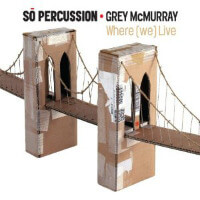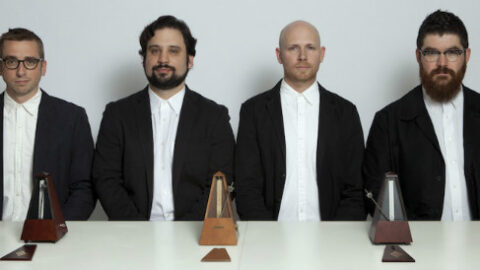 A makeshift model of the Brooklyn Bridge built out of old cardboard boxes resides on the front of the new Sō Percussion and Grey McMurray collaboration, Where (we) Live. The imagery is apropos for both Sō and McMurray in that the album is meant to question what “home” can mean. What are its boundaries? How does it evolve, and what creates those evolutions? The album certainly communicates these questions (and many others) as a standalone creation, but the liner notes mention that the music heard here is actually a distillation of a larger project. In their effort to answer the seemingly endless questions that arise from a concept as slippery as “home,” Sō invited artists of all types to “substantively alter our process,” (more on this later).
A makeshift model of the Brooklyn Bridge built out of old cardboard boxes resides on the front of the new Sō Percussion and Grey McMurray collaboration, Where (we) Live. The imagery is apropos for both Sō and McMurray in that the album is meant to question what “home” can mean. What are its boundaries? How does it evolve, and what creates those evolutions? The album certainly communicates these questions (and many others) as a standalone creation, but the liner notes mention that the music heard here is actually a distillation of a larger project. In their effort to answer the seemingly endless questions that arise from a concept as slippery as “home,” Sō invited artists of all types to “substantively alter our process,” (more on this later).

Where (we) Live wastes no time in communicating its topic. A landscape of repetitive piano music provides a backdrop for “This Place the Place.” The track is dominated by a voice over that begins, “This is my home,” and then invites you to “Close your eyes and think of your home.” The monologue continues through the entire opening track, and contains so many aphorisms about “home” that it ends with the word “yeah” in place of “home” in an effort to avoid being either tawdry or aggressive (or both). A musical dialogue is created between the spoken words and punctuating electronic sounds, which foreshadows a great deal of the organization on the album. A much less active piano motive provides another soundscape for the second track, which features another voice over during the opening section, and builds to a raucous climax that includes both acoustic and electronic sounds.
 During an interview about the project, McMurray said that there was a great deal of warmth to the music on Where (we) Live, but that these moments of warmth were purposefully met with moments that were upsetting and distant. Much of the remaining music is dominated by the very musical dialogue of which McMurray is speaking. A texture dominated by stick clicks leads to a section of similarly active metallic sounds, which is followed by an insanely catchy drum groove in “Strange Steps.” Another spoken monologue is altered electronically to resemble some of the noises heard in the first track in “Room and Board.” Of the remaining tracks, though, “Strangers All Along” was without doubt my favorite. After listening to the stylistic conversation that dominated most of the album, this track seemed finally to blend each of those styles and ask them to make a statement as a single voice. What comes out is a beautifully crafted and heartfelt piece of music that has stunning poignance.
During an interview about the project, McMurray said that there was a great deal of warmth to the music on Where (we) Live, but that these moments of warmth were purposefully met with moments that were upsetting and distant. Much of the remaining music is dominated by the very musical dialogue of which McMurray is speaking. A texture dominated by stick clicks leads to a section of similarly active metallic sounds, which is followed by an insanely catchy drum groove in “Strange Steps.” Another spoken monologue is altered electronically to resemble some of the noises heard in the first track in “Room and Board.” Of the remaining tracks, though, “Strangers All Along” was without doubt my favorite. After listening to the stylistic conversation that dominated most of the album, this track seemed finally to blend each of those styles and ask them to make a statement as a single voice. What comes out is a beautifully crafted and heartfelt piece of music that has stunning poignance.
This album does have a precedent in Sō’s discography—Treasure States, their collaboration with Matmos, was also a composition and performance collaboration—but it does not lack novelty. I have not had the opportunity to see a live performance of the project, but there is an extended YouTube clip that demonstrates some of the artistic contributions not available on the album, which include video projections and choreography. For example, about 2:30 into the performance a video of a man brushing his teeth is projected on a small screen behind the musicians as they perform. Just after 59:15, Emily Johnson, the choreographer collaborating in the project, begins passing notes to members of the ensemble directing them to do things in the performance space (she discusses this at about 48:15). One of the points that Grey McMurray makes during the shorter YouTube clip (also linked above) is that the musicians wanted to create the possibility of spontaneity. Although the visual elements are occasionally difficult to associate with the music, they almost certainly present the opportunity for spontaneous musical thought.
I have to admit that the first time I listened to this album I wasn’t crazy about all of it. Some of the early tracks seemed to lack continuity due to the diversity of styles and ideas. This changed, however, with “Strangers All Along” and “Thank You,” which unified the album into an incredibly unique artistic statement about what “home” might mean. Once I heard the humanity in “Thank You”—in which a chorus of voices leads to a lone singer—it was nearly impossible not to listen from the beginning again. This is not an album that reveals its most attractive qualities during the first listen. You have to warm up to it. Just like…”yeah.”
Sō Percussion, Where (we) Live (Cantaloupe CA21087, September 2012) | Buy it on Amazon
—
Justin Rito is a composer, pianist, runner, Detroit Tigers fan, and microbrew lover currently living in London, Ontario.
























